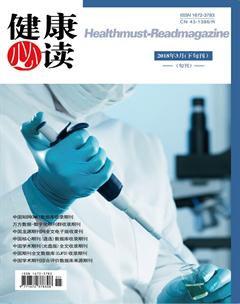母體環境暴露與胎兒先天性心臟病病因的相關性研究
蔡貴榕
【摘要】目的:探討母體環境暴露與胎兒先天性心臟病(congenital heart disease, CHD)病因的相關性, 對CHD的預防進行臨床指導。方法:回顧性分析 2014.11~2017.11來我院就診的62例先天性心臟病胎兒的母親為觀察組,同期出生的62例健康胎兒的母親為對照組,通過本院自制的調查問卷,對兩組胎兒的母親家族史、生育年齡、民族、健康狀況、孕產史、藥物接觸史、農藥接觸史、孕前及孕期環境嘈雜情況、孕期胎兒情況、教育情況、不良生活史、收入情況、工作情況等情況進行調查分析。結果:觀察組女性胎兒比例顯著高于對照組,差異有統計學意義,P<0. 05 ;觀察組母親的先天性心臟病家族史、生育年齡、健康狀況、流產史、藥物接觸史、農藥接觸史、噪聲、不良妊娠史、胎兒異常、不良生活史、收入等因素與對照組相比,差異有統計學意義,P<0. 05。結論:母體孕前期和孕期的多種環境因素與胎兒先天性性臟病的發生相關,改善母體的健康狀況,減少危險因素的暴露,對防控胎兒先天性心臟病的發生具有重要意義。
【關鍵詞】母體;環境因素;胎兒;先天性心臟病;相關性
Relationship between maternal environmental exposure and etiology of fetal congenital heart disease
Abstract Objective: To explore the relationship between maternal environmental exposure and the etiology of fetal congenital heart disease (CHD) and to provide clinical guidance for the prevention of CHD. Methods : The mothers of 62 congenital heart disease fetuses who visited our hospital from 2014.11 to 2017.11 were retrospectively analyzed. The mothers of 62 healthy fetuses born in the same period were the control group, t hrough the self-made questionnaire in our hospital, we analyzed the mother's family history, birth age, ethnicity, health status, mother's history, drug exposure history, history of exposure to pesticides, noisy environment before and during pregnancy, fetus during pregnancy, education situation , Bad life history, income, work conditions and other circumstances for investigation and analysis. Results: The proportion of female fetuses in observation group was significantly higher than that in control group, the difference was statistically significant (P <0.05); compared with the control group, the factors such as family history of congenital heart disease, childbearing age, health status, abortion history, drug exposure history, history of pesticide exposure, noise, adverse pregnancy history, fetal abnormalities, adverse life history, The difference was statistically significant, P <0.05. Conclusion: The maternal preconception and pregnancy multiple environmental factors associated with the occurrence of fetal congenital heart disease, improve the health status of maternal and reduce exposure of risk factors, prevention and control of fetal congenital heart disease is of great significance.
Key words: maternal; environmental factors, fetus, congenital heart disease, relativity
【中圖分類號】 R54l
【文獻標識碼】 B
【文章編號】 1672-3783(2018)03-03-024-01
先天性心臟病(congenital heart disease, CHD)[1, 2]是臨床常見的一種先天性畸形,主要是由于受環境、遺傳等因素影響,胎兒心血管在胚胎發育過程中局部解剖結構的異常發育,或胎兒出生后,該自行閉合的通道未閉合而發生[3, 4]。近年來,隨著社會的發展,環境的污染[5, 6],生活壓力的增加[7],先天性心臟病的發病率逐漸升高[8],嚴重影響了患兒的生活質量,也給家庭和社會帶來巨大的經濟和心理負擔,因此,如何有效防治先天性心臟的發生,成為全民關注的重點[9]。目前研究普遍認為,先天性心臟病的發生和遺傳因素[10]、母體因素[11]、環境因素、表觀遺傳因素等相關,尋找先天性心臟病的相關危險因素,并進行積極、有效地防治,已成為預防先天性心臟病發病的一級課題。本研究旨在探討母體環境暴露與胎兒先天性心臟病病因的相關性, 以期對先天性心臟病的預防進行臨床指導。
1資料和方法
1.1一般資料選取2014.11~2017.11來我院就診的62例先天性心臟病胎兒的母親為觀察組,同期出生的62 例健康胎兒的母親為對照組。所有觀察組胎兒均經過彩色多普勒或手術等確證為先天性心臟病,具體分類見表1。排除標準:①心肌炎患兒;②伴發其他先天性疾病患兒;③嚴重心、肝、腎功能障礙患兒;④母親無法配合完成調查問卷者。所有入選者都了解此項研究,并簽署知情同意書。
1.2方法采用本院自制的調查問卷,對兩組對象進行面對面的調查,調查內容主要包括母親一般情況(姓名、民族、生育時年齡、既往病史,吸煙和飲酒等不良生活史、妊娠史、收入、職業、文化程度等)和可疑危險因素暴露情況(藥物接觸史、農藥接觸史、孕前及孕期環境嘈雜情況等)。由本項目組成員對調查表的內容進行審核并錄入。
1.3統計學處理采用SPSS19.0統計學軟件進行分析。計量資料用均值±標準差(x±s)來表示,組間比較采用 t 檢驗;計數資料用百分比(%)來表示,組間比較采用x2檢驗。均采用雙側檢驗,以 P< 0. 05 為差異有統計學意義。
2結果
觀察組女性胎兒比例顯著高于對照組,差異有統計學意義,P<0. 05;觀察組母親的先天性心臟病家族史、生育年齡、健康狀況、流產史、藥物接觸史、農藥接觸史、孕前及孕期環境嘈雜情況、不良妊娠史、胎兒異常、不良生活史、收入因素與對照比相比有顯著差異 P<0. 05,結果見表2。
3討論
先天性心臟病一種常見的出生缺陷[12, 13],嚴重威脅了患兒的生命健康,近年來隨著社會的發展,環境因素的污染,備孕婦女生活壓力的增加,先天性心臟病胎兒的出生率逐年增高,成為嚴重影響優生優育的公共衛生難題。但對于先天性心臟病的病因還未明確,目前普遍認為是遺傳[10]和環境因素共同作用的結果,妊娠早期(第 3~8 周)是胚胎心臟發育的關鍵時期[14],此期間若母體受到不良環境因素的刺激,則容易影響胎兒心臟的發育,導致胎兒先天性心臟病的發生[15, 16]。
本研究發現,母體的先天性心臟病家族史、高生育年齡、健康狀況差、流產、藥物接觸史、農藥接觸史、噪聲干擾史、不良妊娠史、胎兒異常、不良生活史、低收入等因素均會導致胎兒先天性心臟病的發病率升高。隨著年齡的增高,卵子的質量會逐漸下降,先天性心臟病胎兒的出生率也會升高;自然流產是淘汰先天缺陷胚胎的一種自然規律,因此既往有流產、不良妊娠史會導致胎兒出生缺陷的比例增加;若產婦的身體健康狀況較差,也會對胎兒造成影響,增加胎兒畸形的發生,尤其是心血管系統和神經系統的影響最明顯[17];孕期的用藥或有毒物質接觸史,會通過血液循環影響胎兒,導致胎兒的異常發育,使先天性心臟病的發生率增加; 生活環境中的噪音以低頻為主,易與人體臟腑產生共振,長期處于噪聲干擾的環境下,可損傷孕婦心、肝、肺、腎等重要器官,使孕婦機體各項功能降低,進而影響胎兒各個系統的發育情況,導致先天性心臟病的發病率增加。
綜上所述,我們通過分析找出了一些先天性心臟病胎兒發病相關的母體因素,因此,對于計劃懷孕的婦女應加強自我保健意識,對可能的危險因素進行積極防范,盡量避免危險因素的暴露,建立良好的生活方式,注重孕前保健。同時,提高產前診斷和保健水平,提高產婦的保健質量,做好一級預防,對防控先天性心臟病胎兒的出生,提高人口質量具有重要意義。
參考文獻
[1]Connolly HM. Managing congenital heart disease in the obstetric patient[J]. Semin Perinatol, 2018, 42(1): 39-48.
[2]Ernst MM, Marino BS, Cassedy A, et al. Biopsychosocial Predictors of Quality of Life Outcomes in Pediatric Congenital Heart Disease[J]. Pediatr Cardiol, 2018, 39(1): 79-88.
[3]Chakravarti S,Busovsky-McNeal M. Use of Tolvaptan in a Patient With Palliated Congenital Heart Disease[J]. World J Pediatr Congenit Heart Surg, 2018, 9(1): 114-116.
[4]Bartra S. Transcatheter Pulmonary Valve Replacement in Patients With Congenital Heart Disease[J]. Crit Care Nurse, 2018, 38(1): 30-36.
[5]Vecoli C, Pulignani S, Foffa I, et al. Congenital heart disease: the crossroads of genetics, epigenetics and environment[J]. Curr Genomics, 2014, 15(5): 390-9.
[6]Garg V,Basu M. Beyond genetics: focusing on maternal environment for congenital heart disease prevention[J]. Evid Based Med, 2014, 19(2): e8.
[7]Kako H, Alkhatib O, Krishna SG, et al. Changes in intracuff pressure of a cuffed endotracheal tube during surgery for congenital heart disease using cardiopulmonary bypass[J]. Paediatr Anaesth, 2015, 25(7): 705-10.
[8]VanderPluym CJ, Cedars A, Eghtesady P, et al. Outcomes following implantation of mechanical circulatory support in adults with congenital heart disease: An analysis of the Interagency Registry for Mechanically Assisted Circulatory Support (INTERMACS)[J]. J Heart Lung Transplant, 2018, 37(1): 89-99.
[9]Muller J, Ewert P,Hager A. Number of thoracotomies predicts impairment in lung function and exercise capacity in patients with congenital heart disease[J]. J Cardiol, 2018, 71(1): 88-92.
[10]Blue GM, Kirk EP, Sholler GF, et al. Congenital heart disease: current knowledge about causes and inheritance[J]. Med J Aust, 2012, 197(3): 155-9.
[11]Begum S,Dey SK. Clinical profile and pattern of congenital heart disease in infants of diabetic mother and infants of non-diabetic mother at a tertiary care hospital[J]. J Neonatal Perinatal Med, 2017, 10(4): 403-408.
[12]Huang HR, Chen CW, Chen CM, et al. A positive perspective of knowledge, attitude, and practices for health-promoting behaviors of adolescents with congenital heart disease[J]. Eur J Cardiovasc Nurs, 2018, 17(3): 217-225.
[13]Koenraadt WMC, Bartelings MM, Bokenkamp R, et al. Coronary anatomy in children with bicuspid aortic valves and associated congenital heart disease[J]. Heart, 2018, 104(5): 385-393.
[14]Jaffe AS. Improving the Specificity of Cardiac Biomarkers-The Early Development of Cardiac Troponin I (cTnI) Assays[J]. Clin Chem, 2018, 64(3): 609-610.
[15]Stroud MJ, Fang X, Zhang J, et al. Luma is not essential for murine cardiac development and function[J]. Cardiovasc Res, 2018, 114(3): 378-388.
[16]Motohashi Y, Shimada R, Sasaki T, et al. Development of a simple device enabling percutaneous flow regulation for a small vascular graft for a Blalock-Taussig shunt capable of flow regulation: complete translation of a review article originally published in Pediatric Cardiology and Cardiac Surgery (154-159, 2016: vol. 32)[J]. Gen Thorac Cardiovasc Surg, 2018, 66(3): 145-149.
[17]Peyvandi S, Kim H, Lau J, et al. The association between cardiac physiology, acquired brain injury, and postnatal brain growth in critical congenital heart disease[J]. J Thorac Cardiovasc Surg, 2018, 155(1): 291-300 e3.

